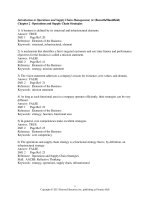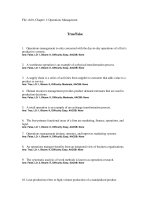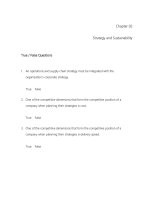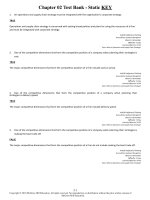Lecture Operations and supply chain management: The Core (3/e) – Chapter 3: Forecasting
Bạn đang xem bản rút gọn của tài liệu. Xem và tải ngay bản đầy đủ của tài liệu tại đây (638.72 KB, 14 trang )
Forecasting
Chapter 03
McGrawHill/Irwin
Copyright © 2013 by The McGrawHill Companies, Inc. All rights reserved.
Learning Objectives
1.
2.
3.
4.
5.
6.
Understand the role of forecasting as a basis for
supply chain planning
Identify the basic components of demand:
average, trend, seasonal, and random variation
Show how to make a time series forecast using
moving averages, exponential smoothing, and
regression
Use decomposition to forecast when trend and
seasonality is present
Show how to measure forecast error
Describe the common qualitative forecasting
techniques, such as the Delphi method and
collaborative forecasting
32
The Role of Forecasting
Forecasting is a vital function and impacts every
significant management decision
Finance and accounting use forecasts as the basis for
budgeting and cost control
Marketing relies on forecasts to make key decisions
such as new product planning and personnel
compensation
Production uses forecasts to select suppliers,
determine capacity requirements, and to drive
decisions about purchasing, staffing, and inventory
Different roles require different forecasting
approaches
Decisions about overall directions require strategic
forecasts
Tactical forecasts are used to guide day-to-day
decisions
33
Components of Demand
Excel: Components
34
Time Series Analysis
Using the past to predict the future
35
Forecasting Method Selection
Guide
Fo re c as ting Me tho d
Amo unt o f His to ric al
Data
Data Patte rn
Fo re c as t
Ho rizo n
Simple moving
average
6 to 12 months; weekly
data are often used
Stationary (i.e. no
trend or
seasonality)
Short
Weighted moving
5 to 10 observations
average and simple
needed to start
exponential smoothing
Stationary
Short
Exponential smoothing 5 to 10 observations
with trend
needed to start
Stationary and
trend
Short
Linear regression
Stationary, trend,
and seasonality
Short to
Medium
10 to 20 observations
36
Forecast Error Measurements
Ideally, MAD will be zero
(no forecasting error)
Larger values of MAD
indicate a less accurate
model
MAPE scales the forecast error
to the magnitude of demand
Tracking signal indicates
whether forecast errors are
accumulating over time (either
positive or negative errors)
37
Computing Forecast Error
38
Causal Relationship
Forecasting
Causal relationship forecasting uses
independent variables other than time to
predict future demand
This independent variable must be a leading
indicator
Many apparently causal relationships are
actually just correlated events – care must be
taken when selecting causal variables
39
Multiple Regression Techniques
Often, more than one independent variable
may be a valid predictor of future demand
In this case, the forecast analyst may utilize
multiple regression
Analogous to linear regression analysis, but with
multiple independent variables
Multiple regression is supported by statistical
software packages
310
Qualitative Forecasting
Techniques
Generally used to take advantage of expert
knowledge
Useful when judgment is required, when
products are new, or if the firm has little
experience in a new market
Examples
Market research
Panel consensus
Historical analogy
Delphi method
311
Collaborative Planning,
Forecasting, and Replenishment
(CPFR)
A web-based process used to coordinate the
efforts of a supply chain
Demand forecasting
Production and purchasing
Inventory replenishment
Integrates all members of a supply chain –
manufacturers, distributors, and retailers
Depends upon the exchange of internal
information to provide a more reliable view of
demand
312
CPFR Steps
313
Principles
Forecasting is a fundamental step in any
planning process
Forecast effort should be proportional to the
magnitude of decisions being made
Web-based systems (CPFR) are growing in
importance and effectiveness
All forecasts have errors – understanding and
minimizing this error is the key to effective
forecasting processes
314









